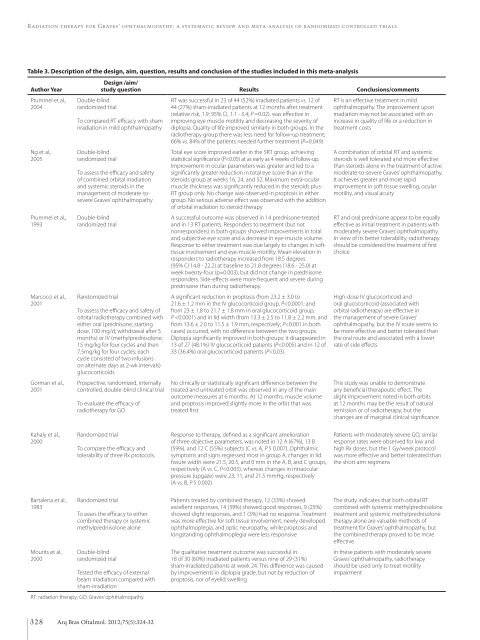Ocular rosacea Crotoxin for paralysis of extraocular muscles ...
Ocular rosacea Crotoxin for paralysis of extraocular muscles ...
Ocular rosacea Crotoxin for paralysis of extraocular muscles ...
Create successful ePaper yourself
Turn your PDF publications into a flip-book with our unique Google optimized e-Paper software.
Radiation therapy <strong>for</strong> Graves’ ophthalmopathy: a systematic review and meta-analysis <strong>of</strong> randomized controlled trials<br />
Table 3. Description <strong>of</strong> the design, aim, question, results and conclusion <strong>of</strong> the studies included in this meta-analysis<br />
Author Year<br />
Prummel et al.,<br />
2004<br />
Ng et al.,<br />
2005<br />
Prummel et al.,<br />
1993<br />
Marcocci et al.,<br />
2001<br />
Gorman et al.,<br />
2001<br />
Double-blind<br />
randomized trial<br />
Design /aim/<br />
study question Results Conclusions/comments<br />
To compared RT efficacy with sham<br />
irradiation in mild ophthalmopathy<br />
Double-blind<br />
randomized trial<br />
To assess the efficacy and safety<br />
<strong>of</strong> combined orbital irradiation<br />
and systemic steroids in the<br />
management <strong>of</strong> moderate-tosevere<br />
Graves’ ophthalmopathy<br />
Double-blind<br />
randomized trial<br />
Randomized trial<br />
To assess the efficacy and safety <strong>of</strong><br />
orbital radiotherapy combined with<br />
either oral (prednisone; starting<br />
dose, 100 mg/d; withdrawal after 5<br />
months) or iv (methylprednisolone;<br />
15 mg/kg <strong>for</strong> four cycles and then<br />
7.5mg/kg <strong>for</strong> four cycles; each<br />
cycle consisted <strong>of</strong> two infusions<br />
on alternate days at 2-wk intervals)<br />
glucocorticoids<br />
Prospective, randomized, internally<br />
controlled, double-blind clinical trial<br />
To evaluate the efficacy <strong>of</strong><br />
radiotherapy <strong>for</strong> GO<br />
RT was successful in 23 <strong>of</strong> 44 (52%) irradiated patients vs. 12 <strong>of</strong><br />
44 (27%) sham-irradiated patients at 12 months after treatment<br />
(relative risk, 1.9; 95% CI, 1.1 - 3.4; P =0.02). was effective in<br />
improving eye muscle motility and decreasing the severity <strong>of</strong><br />
diplopia. Quality <strong>of</strong> life improved similarly in both groups. In the<br />
radiotherapy group there was less need <strong>for</strong> follow-up treatment;<br />
66% vs. 84% <strong>of</strong> the patients needed further treatment (P=0.049)<br />
Total eye score improved earlier in the SRT group, achieving<br />
statistical significance (P

















